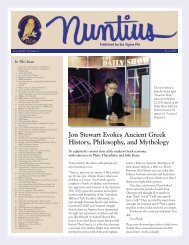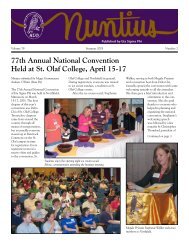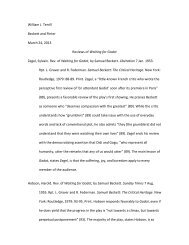Published by Eta Sigma Phi - Monmouth College
Published by Eta Sigma Phi - Monmouth College
Published by Eta Sigma Phi - Monmouth College
Create successful ePaper yourself
Turn your PDF publications into a flip-book with our unique Google optimized e-Paper software.
Hellenistic Music and the Kithara<strong>by</strong> Kira Jones of Epsilon Iota at the Universityof FloridaNote: This paper was voted the best studentpaper read at the 2007 convention in<strong>Phi</strong>ladelphia.Music was a central element in manyaspects of Greek life, whether as entertainment,education, or as a part of a religiousceremony. It continued to play an importantrole in Hellenistic society, but theforeign influences that Alexander, in part,introduced to the Greek world changedits music forever. The kithara, a stringedinstrument popular in many circles, was atthe forefront of this musical revolution. Inorder to understand the kithara’s evolutionas a social instrument, however, one mustfirst look at its history.In the late fifth/early fourth centuriesBCE, the Greek world was subjected to anincursion of what scholars now call “newmusic.” This music entailed many things,but foremost among them were advancesin instrument technology that allowed performersto go beyond the proper harmoniaof their forefathers. Many contemporaryintellectuals discounted these musicalinnovations, some even going so far asto say they were destroying music (West357). Plato, when describing his idealcity, refuses to allow “multi-stringed orpoly-harmonic instruments,” or the aulos,which he calls, “the most multi-stringedof all” (R. 399c-d). He most likely meanspolyharmonic when he says multi-stringedsince the aulos was a wind instrument.Plato also decries note intervals that areeither too close or far apart, as well asexcessively high or low pitches, songs thatare played either too quickly or too slowly,and general poikilmata (elaborate ornamentation)regarding rhythm (Maas 169).Regardless of the intellectual opinion,new music created a new public opinion ofperformance. Instead of praising composers,people began to focus on the performers.The key to a good performance,apparently, was virtuoso skill, personalityand stage presence. The best performer,according to M.L West, was the Thebanaulete Pronomus. Pronomus not only possessedvirtuoso skill, but also “captivatedaudiences not just <strong>by</strong> his playing but <strong>by</strong> hisfacial expression and the whole movementof his body.” The fact that he wasfeatured on a vase, which is now displayedin Naples, attests the newly developedappreciation for performers (West 366).As performers concentrated on becomingmore skilled, they ushered in evenmore advances in instrument construction.Pronomus is said to have devised a way ofmaking multimodal auloi, and the kitharagradually became elongated and acquiredup to twelve strings <strong>by</strong> some accounts(West 367). These new modes, along withthe new-found skill of many artists, led tocomposers “who inaugurated unmusicalrule breaking, poetic spirits <strong>by</strong> nature butinsensitive to the Muse’s rights and principles,running wild and unduly possessed <strong>by</strong>pleasure, blending dirges with hymns andpaeans with dithyrambs, making citharodysound like aulody, combining everythingwith everything, misled <strong>by</strong> their folly intodenying that music has any true standardat all….” (Leg. 669c-670a, 700a-701a).The masses would have loved a performerwho seemingly had no limitations in hismusic, but that same performer must haveinfuriated those trying to preserve Greektradition.Their best efforts, however, could notpreserve Greek musical tradition in its pristineform. Indeed, the famed Aristoxenusis one of the last composers we actuallyknow from this period. This is not to saythat Greek composers ceased to exist, butthe public focus had shifted so dramaticallytowards the performer that composerssimply were not lauded as they once were.Alexander himself initiated a musicaltrend, as he is reported to have employedone rhapsode, three psilocitharists, twocitharodes, two aulodes, five auletes, threetragic and three comic actors, as well asa harpist at his five-day wedding festival.Ptolemy II followed Alexander’s lead <strong>by</strong>employing six hundred male vocalists asa choir for his Alexandrian procession in282 BCE, and no less than thirty citharodesto accompany the vocalists in their march(West 373-4). After these examples, bothMacedonia and Alexandria continued toenjoy numerous royal festivals throughoutthe Hellenistic age.The kithara was made of wood, and differedfrom the lyre in both sound-box sizeand sonority. From the pictorial evidencewe have, it was held upright while playing,and may have been inclined towards theplayer during performance. There wasusually a ribbon that went around themusician’s left wrist to help support theinstrument while he/she used a plektron (apick-like device) to play. The number ofstrings varies, but from artistic and literaryevidence it seems that there were always atleast five strings (West 173).During the late classical age, kitharaperformers had only just begun to pursueactual musical careers, and so the instrumentwas still considered somewhat of aholy, refined activity. Thus, practically allof the vases from that classical era showthe kithara in conjunction with Apollo,who is often himself contesting withMarsyas. Early Hellenistic artists depictedthis myth many times, and the reasonfor this is evident if one looks at the timeperiod. There was still a conflict over therole of new music in Greek society. Early inthe myth, it is said that Athena inventedthe aulos but threw it away, only for it tobe found <strong>by</strong> Marsyas. Athena, especially inAttica, was a goddess of civilization. If sherejected the instrument, which was lateradopted <strong>by</strong> a satyr (representing non-civilization)then the aulos evidently was notgood enough for erudite company. Apolloalso represents civilization, in the sense ofproper music. He is always depicted withthe traditional kithara (as opposed to thenewer Hellenistic or Italiote models, whichwill be discussed later), and he alwayswears traditional clothing.Marsyas, on the other hand, is doomedfrom the beginning. His bestial naturesomehow draws him to the aulos, whichwas the instrument at the forefront of newmusic. He is naked, as opposed to Apollo’sfinery, and his hair is unkempt, as opposedto Apollo’s finely groomed ephebic look. Itseems that what the Hellenistic artists hadin mind was a direct comparison betweennew music and the traditional ways: newmusic had to fail. It was against the verylaws of nature and culture for a mere beastto triumph over a god, and Marsyas clearlyrepresents the new influences that werethreatening the “sacred” way of music.The Hellenistic kithara first appearson vases during the late fifth century16
















